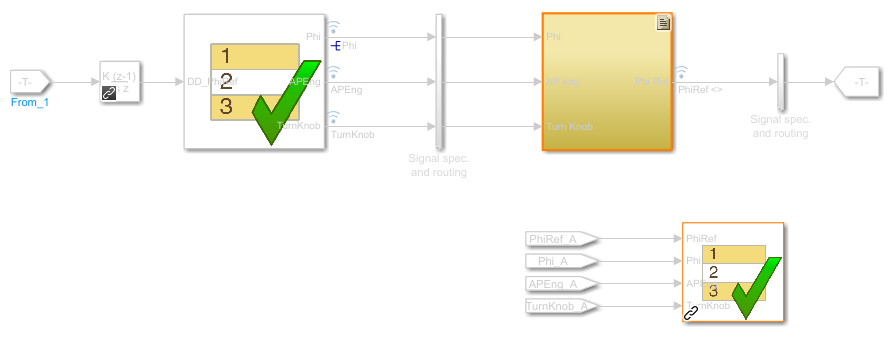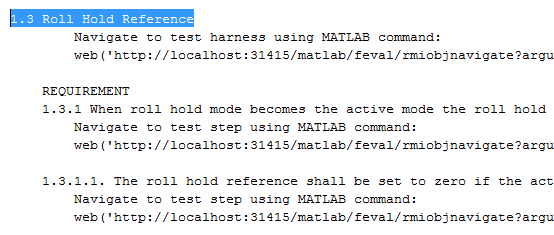链接至需求
由于需求指定了对特定条件的响应行为,因此您可以根据模型需求开发测试输入、预期输出和评估。
需求可追溯性注意事项
考虑使用测试框架中的需求链接时的以下限制:
在测试框架重建操作期间,一些模块和子系统被重新创建。测试框架中不支持这些模块和子系统的需求链接:
被测组件与信源或信宿之间的转换子系统
Test Sequence 模块用于调度函数调用
将控制输入信号驱动至被测组件的模块
驱动 Goto 或 From 模块的模块,这些模块传递被测组件信号
Data Store Read 和 Data Store Write 模块
如果使用外部需求存储,执行以下操作需要重新建立到测试框架内的模型对象的需求链接:
使用测试框架剪切/粘贴或复制/粘贴子系统
克隆测试框架
将测试框架从链接模块移动到库模块
建立测试需求可追溯性
如果您拥有 Simulink® Test™ 和 Requirements Toolbox™ 许可证,您可以将需求链接到测试框架、测试序列和测试用例。
测试框架的需求可追溯性
当您编辑指向被测组件的需求链接时,该链接会立即在测试框架和主模型之间同步。对被测组件的其他更改(例如添加模块)会在关闭测试框架时同步。如果向被测组件添加了模块,请在添加需求链接之前关闭并重新打开框架以更新主模型。
要查看带有需求链接的项目,请在 App 选项卡上的“模型验证、确认和测试”下点击需求管理器。在需求选项卡中,点击突出显示链接 ![]() 。
。
测试序列的需求可追溯性
在测试序列中,您可以链接到测试步骤。要创建链接,首先找到要链接到的模型项、测试用例或文档中的位置。右键点击测试步骤,选择需求,添加链接或打开链接编辑器。
要突出显示或删除具有需求链接的测试步骤的突出显示,请切换测试序列编辑器工具条中的需求链接突出显示按钮  。突出显示测试步骤也会突出显示模型模块图。
。突出显示测试步骤也会突出显示模型模块图。
测试用例的需求可追溯性
如果您在单个测试框架中使用了许多测试用例,请链接到每个特定的测试用例,以区分哪些模块和测试步骤适用于它。要将测试步骤或测试框架模块链接到测试用例,
在测试管理器中打开测试用例。
在左侧窗格中的测试浏览器选项卡中,选择测试用例。
在 Simulink 的 App 选项卡中,点击需求管理器。
要将测试用例链接到:
Simulink 模块,右键点击该模块并从上下文菜单中选择 需求 > 链接到当前测试用例。
测试步骤,双击测试框架中的测试序列模块以打开测试序列编辑器。右键点击测试步骤并从上下文菜单中选择 需求 > 链接到当前测试用例。
需求可追溯性示例
此示例演示了如何将需求链接添加到测试框架和测试序列。该模型是自动驾驶仪滚转控制系统的一个组成部分。此示例需要 Simulink Test 和 Requirements Toolbox。
打开模型、测试文件和框架。
openExample("simulinktest/ModelCoverageMATLABUnitExample", ... supportingFile="RollAutopilotMdlRef.slx") openExample("simulinktest/ModelCoverageMATLABUnitExample", ... supportingFile="AutopilotTestFile.mldatx") sltest.harness.open("RollAutopilotMdlRef/Roll Reference",... "RollReference_Requirement1_3")
在测试框架的 App 选项卡上,在模型验证、确认和测试下,点击需求管理器。在需求选项卡中,点击突出显示链接
 。
。测试框架突出显示 Test Sequence 模块、被测组件和 Test Assessment 模块。

为 Discrete Derivative 模块添加可追溯性。
右键点击 Discrete Derivative 模块并选择 需求 > 打开 "出向链接" 对话框。
在需求选项卡中,点击新建。
输入以下内容来建立链接:
描述:
DD link文档类型:文本文件(旧版)
文档:
RollAutopilotRequirements.txt位置:
1.3 Roll Hold Reference

点击确定。Discrete Derivative 模块会突出显示。
要追踪到需求文档,请右键点击 Discrete Derivative 模块,然后选择 需求 > DD 链接@。需求文档在编辑器中打开并突出显示链接的文本。

在测试框架中,打开 Test Sequence 模块。添加将
InitializeTest步骤链接到测试用例的需求链接。在测试管理器的左侧窗格中,在测试浏览器选项卡中,选择
Requirement 1.3 Test。在测试框架中,双击测试序列模块以打开测试序列编辑器。右键点击
InitializeTest步骤并从上下文菜单中选择需求 > 链接到当前测试用例。添加需求链接后,测试序列编辑器会突出显示该步骤。

另请参阅
主题
- 根据需求测试模型并报告结果
- 直接链接到第三方应用程序中的需求 (Requirements Toolbox)